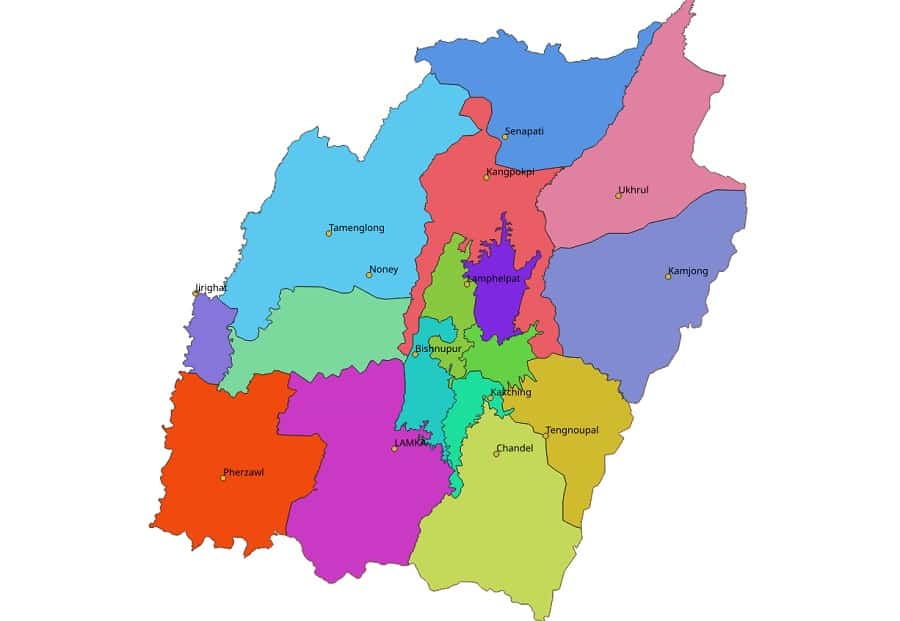Geography

- Location: Northeastern part of India.
- Capital: Imphal
- Main Language: Meiteilon (Meitei)
- Dialects: Tribal dialects such as Tangkhu, Hmar, Paite, Lushai, Mao, Vaiphei, Poula, and Rongmei are heard in Manipur.
- Area: The total area of the state is 22,327 sq km.
- Terrain: Rugged hills, narrow valleys, river basins, and the inner area consists of flat plains.
- Climate: Manipur has an amiable climate, with a predominant temperate climate. Winters are quite chilly, and snowfall occurs occasionally. Summers are comparatively pleasant and warm.
- Best Time to Visit: October to May
- Other Languages Spoken: English
Important Tourist Destinations
- Shree Govindajee Temple: A sacred place for Hindus.
- Keibul Lamjao National Park: A home for 17 rare and endangered species.
- Loktak Lake: A freshwater lake rich in fish and home to a floating island called Phumdi, made of plants and weeds from the lake water.
- Churachandpur: The second-largest city of Manipur, famous for the Khuga Dam.
Transport
- Tulihal Airport in Imphal has direct flights connecting the city to Kolkata, Guwahati, and Delhi.
- Road transport in Manipur is extensive and developed. The roads connect almost all major towns and districts of the state. The total length of roads in Manipur is 7,170 km.
- The state is linked to the rest of the country through National Highway NH-39, which connects to the Dimapur railway station in Nagaland. National Highway NH-53 connects the state with another railway station located in Assam.
History
Prehistoric evidence has been discovered in Manipur, dating back to the Old Stone Age. Near Khangkhui, four caves have been discovered, where Stone Age artifacts such as bone tools, stone tools, and animal remains have been excavated. The discovery of Machi is a landmark in archaeology, confirming the existence of Stone Age people in Manipur. Excavations at the Machi cave led to the discovery of a pebble chopper tool, dating back to 30,000 BC. The state is rich in evidence from the prehistoric period, with tools and other artifacts from the Neolithic age also found in Manipur.
During ancient times, Manipur was ruled by royal dynasties. The state was governed by a capable ruler named Nongda Lairen Pakhangba, whose efforts to develop Manipur are invaluable. His reign saw radical improvements in the state’s culture. He was succeeded by his son, who continued his peaceful rule and further improved the cultural landscape of the state. During his reign, the drum was invented in Manipur.
The medieval period saw the persistent rule of the Meidingu dynasty. Like in ancient times, the rulers of this dynasty prioritized development. One of the greatest queens of this dynasty, Ningthou Khomba Linthoingambi, is remembered for her bravery in resisting an attack by the Tangkhul tribe. She defeated them, leading to their captivity.
The history of Manipur was rewritten with the advent of Vaishnavism during the reign of Meidingu Pamheiba. Under his patronage, Vaishnavism flourished, and Chaitanya schools were established in Manipur. During this time, several battles were fought to expand the boundaries of Manipur, with the present-day Tripura also coming under Manipur’s rule.
During World War II, Manipur witnessed several fierce battles between the Allied forces and Japanese troops. The Japanese could not enter Imphal, as they were repelled by the Allied forces. Post-independence, Manipur was a princely state under British rule from 1891 to 1947. After independence in 1947, the state was governed by a democratic government, with the Maharajas serving as executive heads.
- Must Read: TOP 10 THINGS TO DO IN MANIPUR
Culture
Manipur, hemmed in by hills all around, represents a rich mosaic of traditions and cultural patterns. The state is known for its wealth of art and dance. Every Manipuri girl typically learns singing and dancing. Manipuri dance has been acclaimed in various books and magazines, with laureates praising its style as a pure representation of the state’s tranquil nature. The rhythm and lyrical beauty of the songs and music associated with the dance are appreciated across India. The folk dances of Manipur, such as Lal Haraoba, Pung Cholom, Raslila, Khamba Thaibi, Maibi dance, and Nupa dance, are visually stunning, and dancers often perform internationally. While Manipuri dance is devotional in nature, the dances of the tribal people also captivate audiences with their rhythm and exotic costumes.
The tribal communities of Manipur are primarily of Tibetan and Burmese origin. There are as many as 29 tribal communities in Manipur, each with its unique way of life. Four tribes are commonly found in Manipur: Meiteis and Pangals reside in the lowland valleys, while the Naga and Kuki tribes inhabit the hilly regions. Other Manipuri tribes include Aimal, Angami, Anal, Chiru, Gangte, Chote, Hmar, Kachanaga, Kabui, Kairao, Koirang, Lamgang, Kom, and others.
Also Read: